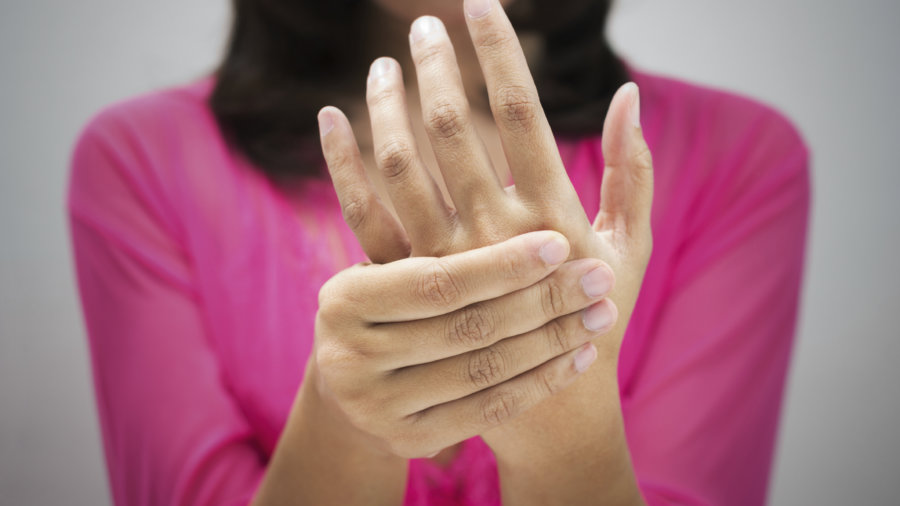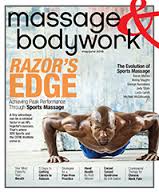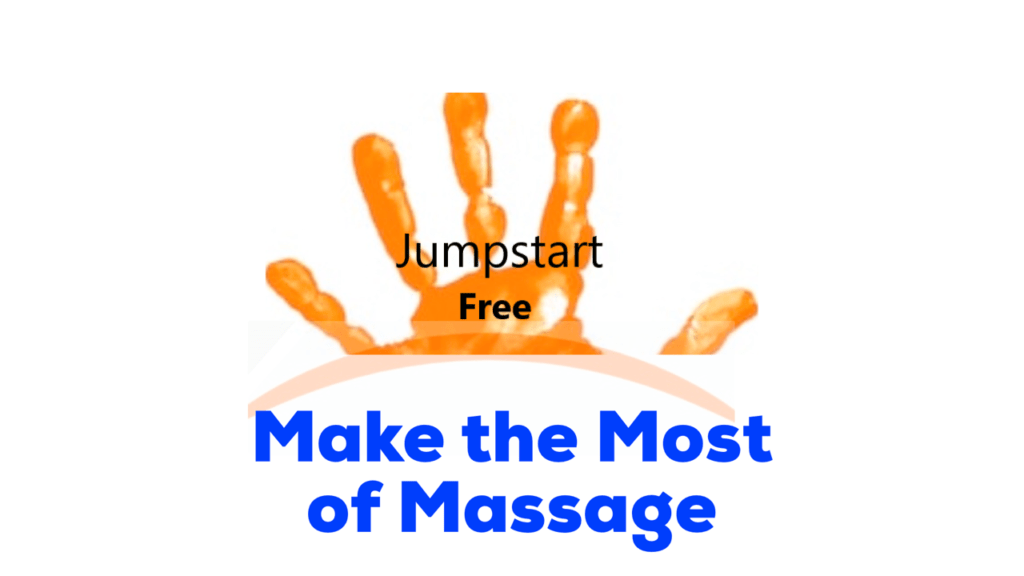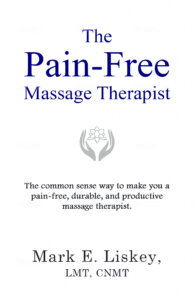How do you eliminate hand pain when doing massage?
- Incorporate your non-dominant hand.
- Add in bracing/combination techniques.
- Use hand-held tools.
I bet you thought I was going to say use your elbows/forearms as substitutes for your hands.
Elbows can be good substitutes for hands, but if you start to rely on your elbow too much you could develop overuse problems, like cubital tunnel syndrome.
In addition, an elbow is great for a back, but how about if you’re doing detail work, like in the neck? For most of us massage therapists, using an elbow to do detail work in cervical erectors is not going to work.
Enter your non-dominant-hand, bracing and combination techniques and massage tools.
1. Massage Therapist Hand Pain – Be Ambidextrous
About 10 years ago, my right thumb started to bother me.
When I think back it makes perfect sense that it would. I used it a lot—especially when doing deep, detail work. For a long time, I simply accepted thumb pain as the price to pay for doing massage.
But as the pain increased I realized that if I didn’t change something soon I was going to be in trouble.
One day during a massage my right thumb was really aching and I had to give it a break. So I stuck my left thumb in the cervical erectors.
It was awkward BUT my left thumb didn’t ache. (Hey, I could get used to this!)
Then I experimented with my left thumb so often that it started to hurt, too.
Eventually, I found that if I followed a thumb workload formula of 60/40 (60% dominant thumb/40% NON-dominant thumb) my thumbs felt great.
2. Massages Therapist Hand Pain – Combine and Brace
Splitting the workload to 60/40 between my thumbs was a big improvement for reducing pain in my right thumb. However, it didn’t solve my problem of achy and stiff fingers.
There was one move in particular that really made my hand ache. The move involved squeezing and rolling the upper trap edge between my thumb and fingers.
One day I was doing that move and my hand ached. Without thinking I reached over with my other hand to help with the squeezing.
Hmm…it sure was a lot easier squeezing with two hands.
And that is when I really started to experiment with combining and bracing.
What happens if I put a thumb over top a thumb and pressed down with both thumbs?
Well, I’ll be damned if that didn’t make the work for my dominant thumb easier.
There are no right or wrong bracing techniques. It depends on the individual and is influenced by anatomy (e.g., big knuckles versus small knuckles) and preexisting conditions.
My favorite hand-saving, bracing combinations are
Braced thumbs: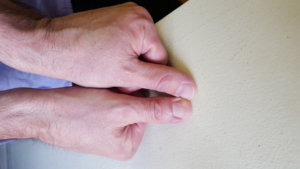
Third knuckle and thumb: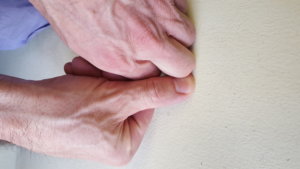
Braced knuckle and fist: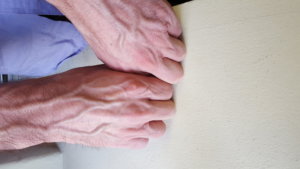
Check out this video for more in-depth bracing and combination techniques:
Here’s my favorite eliminating hand pain solution—massage tools.
3. Massage Therapist Hand Pain – Massage Tools
Becoming ambidextrous and bracing my fingers, thumbs, knuckles and fists together made my hands feel better. But adding in hand-held tools allowed me to increase my massage volume big-time without injuring my hands.
Here are 2 basic types of wooden hand-held tools that I use: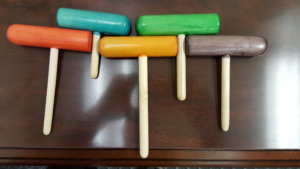
These tools were designed by my massage colleague and friend, Matt Johnson.
Let’s take a closer look.
This is a T-bar.
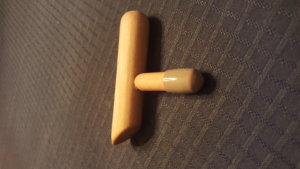
And this is an L-bar.
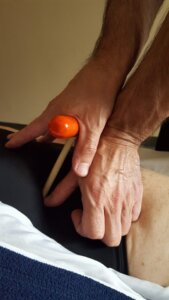
A little intimidating looking, right?
But if you start with baby-steps you’ll get used to them, and then you’ll never want to do another massage without them!
Here’s what you need to do to get competent with massage tools.
Adjustment #1: Relax Your Hand
This is how we were taught to grip a T-bar in NMT class.
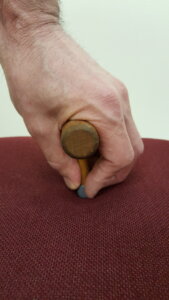
Take note of my fingers gripping the stem and tip to control the T-bar.
This hold allowed you to have fine-tuned control of the T-bar when working a tight/tender spot, but it also encouraged you to grip the T-bar tightly, even when applying light pressure.
Hmm, I wondered, what would happen if I just loosened my grip some?
Actually, nothing happened. The T-bar didn’t slip out of my hand, and I was still able to control the tip with a lighter grip.
This begged the question: How loose can I hold the T-bar without it actually falling out of my hand? I started experimenting and found that my hands were very happy when I simply steadied the T-bar with the minimal amount of pressure required to keep the T-bar from dropping or slipping from my hand.
This is a loose-hand hold:
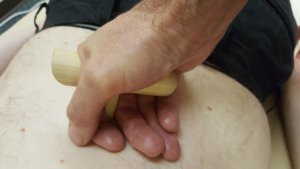
My fingers are relaxed and I’m using just enough of a grip so that T-bar doesn’t slip out of my hand.
At the end of a month or so, I got pretty good with light and medium pressure, but when I ratcheted up to deep, I had to tighten the grip to keep the tool steady.
I wish I could say that I figured out the pain-free method of holding a T-bar for deep pressure within a month or so, but I can’t.
In fact, I went in a different direction altogether. I started experimenting with other massage tools for deep and precise pressure. And it wasn’t until 15 years later that I figured out how to use the T-bar for deep pressure without hurting my hands.
At that time, shoulder and neck conditions forced me to radically change my massage body mechanics. One of the big changes that I made was to set my table lower than I normally had it. And when I did, the T-bar missing puzzle piece fell into place.
Adjustment #2: Pin the T-bar
With a lower table, my work was below me. This meant that I could take full advantage of leaning my body weight into the client to generate pressure.
When I leaned in with a T-bar to do deep pressure, I could pin the T-bar between my hand and the client’s body. There was no need to grip hard to hold the T-bar in place. In fact, I really didn’t have to grip at all. This is an open-hand hold.
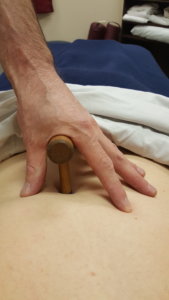
Open hand hold.
To execute this hold the table has to be low enough so that you can lean in to generate pressure and pin the T-bar. Here’s what it looks like when the camera steps back.
The pin technique made it easy to hold the T-bar, but there were times when a one-handed pin wasn’t possible and/or my pinning hand needed a break. This leads us to the third adjustment.
Adjustment #3: Use A Guide Hand Next to the T-bar
Using a guide hand next to a T-bar is my preferred way to hold a T-bar.
For one, I’m contacting the client with more surface area than I would with the T-bar alone. This gives the massage more of a relaxation feel.
Two, it’s really easy to stabilize the T-bar with a guide hand, maintain sensitivity and regulate pressure.
Three, I can shift the emphasis of pressure from tool to guide hand (hand not holding the T-bar) without having to pull my hands off the client.
In this picture my guide hand is a relaxed fist.
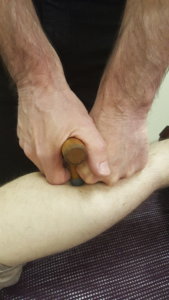
The relaxed-fist, guide hand that’s next to the T-bar serves as a stabilizer. For broader pressure, I would direct more of my body weight into my fist. For precise pressure, I’d lean more into the T-bar. This hold is great for calves and forearms.
This next example is a double-handed hold.
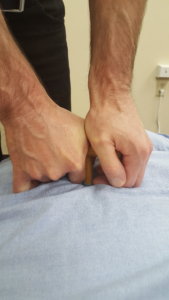
Two hands on the handle hold.
Note that both hands are contacting the handle. Having two hands on the handle allows me to lean in with my body weight. I use this hold when I need to deliver more pressure to influence deep muscles.
The double-handed hold is good for when you’re working thick areas, like back, hamstrings and quads.
Also, can you see that my hands are relaxed? That’s really important because you’ll instinctively want to tighten your grip to steady the T-bar as you lean in to deliver deeper pressure.
But that’ll be completely unnecessary. Look at all the points of contact my fingers and knuckles make with my client’s back. That T-bar is not going anywhere!
This last hold is a wrap-around technique that works well feet.
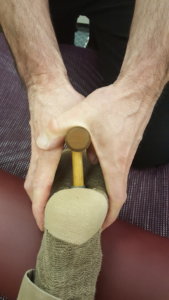
The great thing about the wrap-around hold is that it’s easy to control your pressure. You simply lean in.
The guide-hand and two-handed holds worked great for me, but I had a tendency to get really comfortable with one or two holds and I then I’d feel the overuse pain again. This tendency led to me to adjustment #4.
Adjustment 4: Vary Your Holds
There are countless ways to hold a T-bar. Here’s how I recommend you experiment. First, pin the T-bar between your hand and the client’s body. Then place your other hand next to the T-bar and allow that hand do whatever it wants to in order to support the T-bar.
Just remember to keep your hands relaxed and you’ll be amazed at how many different holds you’ll come up with.
Easier than You Think
There’s a potential irony in massage that we all desperately try to avoid. It goes like this: We put ourselves in pain to get someone else out of pain.
Thumb pain is not a byproduct of doing massage.
Kick thumb pain to the curb by using a T-bar when doing deep and precise work. But first you have to learn how to hold the T-bar without gripping it.
Here are the keys for holding a T-bar:
- Hold the T-bar with a relaxed hand.
- Pin the T-bar between your hand and the muscle by leaning in. You may have to lower your table. You can lean when you’re sitting, too.
- Use a guide hand, thumb, finger next to the T-bar for stability, sensitivity and as a pressure gauge.
- Use two-handed holds to spread the workload.
- Vary your holds so that you don’t overuse a body part.
Once you get these basic things down, you’ll never have to worry about developing chronic thumb pain again.
This video will help you, too:
Eliminate Hand Pain Recap
The great thing about massage is that you can get paid for on-the-job training.
With a paying customer you can experiment with your non-dominant hand.
Once you do that add in a bracing combination, like thumb on thumb.
With hand-held massage tools take it a little slower.
First, practice on friends, colleagues and family.
Once you get positive feedback with your tool work test out a massage tool on a client.
Slowly increase the time you use a massage tool with that client on subsequent sessions.
Online, Save-Your-Body CEU Course
 Need more help saving your hands?
Need more help saving your hands?
I have an online course that can help you eliminate hand pain (and shoulder, neck and back pain, too).
A while back I almost quit massage because of pain and injuries.
Then I spent a year revamping my massage to see if I could massage pain-free. That’s where incorporating the lower half of my body into the massage came in along with a bunch of other strategies that ultimately saved my massage career.
I pulled all that first-hand experience together and made a live CEU class which I taught for about 5 years. During those 5 years I listened to the massage therapists taking the course and worked out the learning kinks.
Check out the kink-free, massage-pain-free course here
Online, Massage Tools CEU Class
Massage tools help saved my hands and upper-body.
Most massage therapists shy away from using massage tools because, less face it, it’s hard to be sensitive with a piece of plastic or a hunk of wood–that is unless you have work-arounds.
I use massage tools in every massage from focused pressure work to total relaxation. I can do this because the work-arounds work and are easy to implement.
So, if you’re ready to take the plunge and delve into massage tools, I have an online, home-study course that will make your learning life easier.
Here it is: How to Use Massage Tools (Fearlessly and Effectively).
